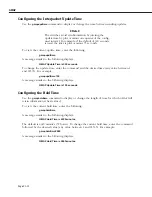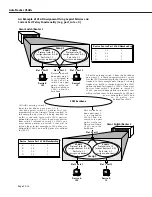
AutoTracker VLANs
Page 22-3
AutoTracker VLANs
AutoTracker
VLAN
s enable you to control communications between end stations in your
network. You define policies that determine membership in the
VLAN
and AutoTracker auto-
matically locates ports or devices within the Group that fit the policies and places them into
the
VLAN
.
You can define physical policies or logical policies (or combinations thereof) to determine
membership in AutoTracker
VLAN
s. Physical policies consist of port rules: you define the
VLAN
members as one or more specific ports and
VLAN
membership is limited to the ports
defined and the
MAC
addresses of devices connected to those ports.
Logical
VLAN
policies can consist of
MAC
address rules, protocol rules, network address rules,
or user-defined rules. Ports are assigned to
VLANs
that have logical rules when the
MPX
exam-
ines frames that originate from devices connected to the Group’s set of ports. If a frame is
received that matches a logical
VLAN
rule, the source device’s
MAC
address and the port to
which the source device is connected are both made
VLAN
members.
The members of an AutoTracker
VLAN
thus consist of source devices originating frames that
fit the
VLAN
’s policies and the ports to which those source devices are connected. Instruc-
tions for creating AutoTracker
VLANs
begin on page 22-16.
AutoTracker VLAN Policies
You can define a maximum of 32 AutoTracker policies of each type per Group. There is no
restriction on the number of rules you can define per
VLAN
, as long as the maximum number
of policies for the Group is not exceeded.
A switch port – or a device connected to a switch port – can belong to more than one
VLAN
simultaneously, as determined by the rules the port or device matches. A port or device is
included in a
VLAN
if it matches any one rule.
You can define the following types of rules:
Port Policies
. Port policies enable you to define membership in the
VLAN
on the basis of ports.
Members of the
VLAN
will consist of devices connected to specific ports on one switch or on
multiple switches in the Group.
MAC Address Policies
.
MAC
address policies enable you to define membership in the
VLAN
on
the basis of devices’
MAC
addresses. This is the simplest type of rule and provides the maxi-
mum degree of control and security. Members of the
VLAN
will consist of devices with
specific
MAC
addresses. These devices may all be connected to one switch or they may be
connected to different switches in the Group. A maximum of 10,240 MAC addresses are
supported per policy.
Protocol Policies
. Protocol policies enable you to define membership in the
VLAN
on the basis
of the protocol that devices use to communicate. All devices that communicate with the speci-
fied protocol become members of the
VLAN
.
You can specify
VLAN
membership according to the following protocols:
IP
,
IPX
, AppleTalk,
or
DECN
et. In addition, you can specify membership according to Ethernet type, source and
destination
SAP
(service access protocol) header values, or
SNAP
(sub-network access proto-
col) type.
Summary of Contents for Omni Switch/Router
Page 1: ...Part No 060166 10 Rev C March 2005 Omni Switch Router User Manual Release 4 5 www alcatel com ...
Page 4: ...page iv ...
Page 110: ...WAN Modules Page 3 40 ...
Page 156: ...UI Table Filtering Using Search and Filter Commands Page 4 46 ...
Page 164: ...Using ZMODEM Page 5 8 ...
Page 186: ...Displaying and Setting the Swap State Page 6 22 ...
Page 202: ...Creating a New File System Page 7 16 ...
Page 270: ...Displaying Secure Access Entries in the MPM Log Page 10 14 ...
Page 430: ...OmniChannel Page 15 16 ...
Page 496: ...Configuring Source Route to Transparent Bridging Page 17 48 ...
Page 542: ...Dissimilar LAN Switching Capabilities Page 18 46 ...
Page 646: ...Application Example DHCP Policies Page 20 30 ...
Page 660: ...GMAP Page 21 14 ...
Page 710: ...Viewing the Virtual Interface of Multicast VLANs Page 23 16 ...
Page 722: ...Application Example 5 Page 24 12 ...
Page 788: ...Viewing UDP Relay Statistics Page 26 24 ...
Page 872: ...The WAN Port Software Menu Page 28 46 ...
Page 960: ...Deleting a PPP Entity Page 30 22 ...
Page 978: ...Displaying Link Status Page 31 18 ...
Page 988: ...Displaying ISDN Configuration Entry Status Page 32 10 ...
Page 1024: ...Backup Services Commands Page 34 14 ...
Page 1062: ...Diagnostic Test Cable Schematics Page 36 24 ...
Page 1072: ...Configuring a Switch with an MPX Page A 10 ...
Page 1086: ...Page B 14 ...
Page 1100: ...Page I 14 Index ...
















































